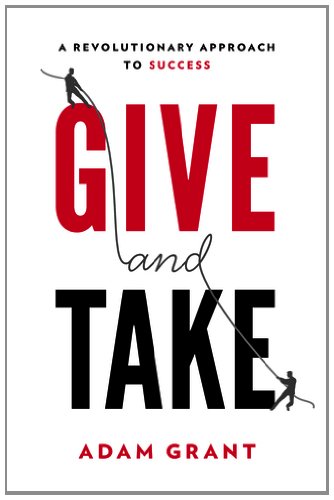I recently read the book Give and Take by Adam Grant after hearing him speak at the Fortune Leadership Summit in May. Grant is a Wharton professor who wanted to prove to his students that they didn’t have to get ahead first to give back; in fact, Grant’s research showed that they could actually be more successful in the long run by being givers.
Grant talks about three primary reciprocity styles, or ways that we interact with others:
• Givers: Give to others without expectation of anything in return
• Takers: Give only when it benefits themselves
• Matchers: Believe in fairness and tit for tat; give with the expectation that the other person will return the favor
Most of us act like givers in our close personal relationships and are willing to do things for our friends and family without expecting anything in return; however, there is a common perception that in order to be successful professionally, we must behave as matchers or takers. While being a taker often pays off in the short run, usually it is the givers who come out ahead professionally; Grant gives numerous examples of successful givers from venture capitalists, financial advisors and defense attorneys to teachers, healthcare providers, professional sports team managers, and even comedians.
Here are some specific areas in which givers have a professional advantage:
1. Networking: Because takers often burn bridges and develop a reputation for being selfish, they usually have smaller networks. Matchers also usually have limited networks because they only develop relationships with people who they think can help them in return. Givers usually have large networks because people they help tend to pay it forward, widening their circle. They develop a reputation for being willing to make an introduction or a recommendation or offer assistance.
2. Collaboration: Givers have an advantage in team settings because they share credit with others and are willing to take on less desirable tasks for the good of the team.
3. Leadership: Because givers recognize the potential in others, they create conditions for other people to thrive. Their willingness to mentor, develop, and offer help to others makes them great leaders.
4. Communication: Often givers have a more tentative rather than dominant communication style, and they tend to ask more questions than takers. Their communication styles make them more likable and more persuasive.
Some of you might be thinking that you would love to be more of a giver at work, but that it would be unrealistic because you’d just be taken advantage of and become burnt out and unproductive. Unfortunately, this does happen to many givers who are selfless and give at their own expense. The trick to being a successful giver is in recognizing that self-interest and other interest are not mutually exclusive. The successful givers are every bit as ambitious about their own careers as the takers, the difference is that they want others to be successful, too… not just themselves.
Here are some tips that Grant gives to being a successful giver:
• Prioritize who you want to help. Realize that you can’t help everyone, and be realistic about how you choose. Do you want to help people that you know you can impact the most? Do you want to help people that you know need help the most?
• Specialize how you can help. Choose something that you enjoy doing and that you can see the benefit of directly. This will help you to stay motivated and energized to continue helping. You’ll make more of an impact in the long run if you choose something you enjoy.
• Plan when you are going to help. Grant’s research shows that givers feel more gratified when they spend a chunk of time helping others rather than short spurts of giving spread out over a period of time. For example, spending two hours once a week helping was more satisfying than spending ten minutes a day.
Grant also advises that successful givers can identify when someone else is taking advantage of them; in those situations, they switch to more of a matcher style with that person to protect themselves from becoming a doormat. It can be useful to be flexible with your reciprocity styles depending on the context.
One way that you can build a culture of giving in your company is by screening out people who are takers in your hiring process. Identify potential takers by asking for references from people who worked for them or by picking up cues on whether they share credit with collaborators on past successes. You can also create an environment that encourages giving by creating a mechanism in which people feel safe asking for help. Grant suggests creating a Reciprocity Ring or having a utility player whose job is specifically to help. Another great avenue for asking for and receiving help is in your Weekly Adjustment Meeting with your team. Asking for help is just as important as giving help in creating a culture of givers.
Still skeptical that giving is the best way to get ahead? Go out there and do a “5 minute favor” for someone or a random act of kindness… write a recommendation for a former colleague or go through your contact list and make a few introductions for people who could benefit knowing each other. Just try it a few times and see if you feel a difference; you never know how your good deed could come back around to you!
Photo Credit: iStock by Getty Images



 LinkedIn
LinkedIn
 Facebook
Facebook